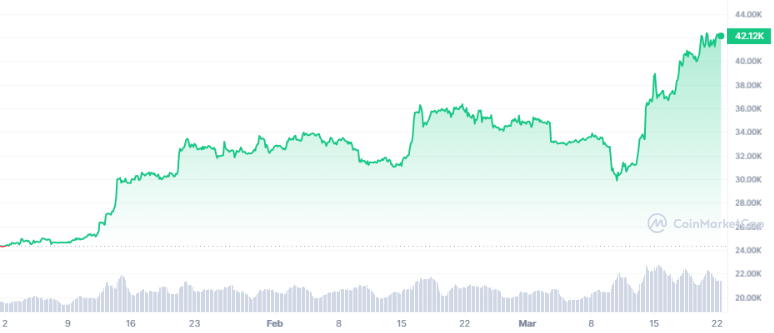Bitcoin Bites Back
“From what we can identify, the only reason today to buy or sell Bitcoin is to make money, which is the very definition of speculation and the very definition of a bubble.” — former Credit Suisse CEO Tidjane Thiam, November 2017.
Thiam might regret his public admonition of Bitcoin as a speculative bubble given recent events involving Credit Suisse, the bank he led between 2015 and 2020.
In November 2017, Bitcoin was trading at around $A10,000 and Credit Suisse shares were about $A24 apiece. Today, after UBS rescued Credit Suisse, the CS share price is $A1.40 and Bitcoin is $A42,000.
In contrast to Credit Suisse, Bitcoin has emerged like a phoenix from the flames of the 2022 crypto wipe-out, rising around 75 per cent from $A24,000 at the start of the year. This is still less than half of Bitcoin’s all time high of $A91,000 in late 2021 but a material rise from 2022’s nadir.

Source: https://coinmarketcap.com/currencies/bitcoin/
Bitcoin’s recovery has coincided with the tumultuous macro backdrop including inflationary fears, interest rate rises and, most significantly, contagion risks in the banking sector. The recent collapses of Signature Bank, Silicon Valley Bank and now Credit Suisse may be the canaries in the coal mine and portents of further chaos to come.
The US Federal Reserve has responded to recent events with a coordinated effort in conjunction with the central banks of the UK, Canada, Japan, Switzerland, and the ECB to enhance liquidity provision via swap line arrangements:

This coordinated effort is an eerie reminder of the prophetic message that the Bitcoin creator Satoshi Nakamoto carved into digital stone within Bitcoin’s genesis block … “The Times 03/Jan/2009 Chancellor on brink of second bailout for banks”.
Bitcoin maximalists often say that Satoshi Nakamoto’s message is a clear pointer to Bitcoin’s difference and value proposition compared with the traditional monetary system based on fiat currency. Bitcoin has no central bank or authority, needs no intermediaries to facilitate transactions, has a fixed and predictable supply schedule, uses an immutable ledger that cannot be readily altered, and employs a game theoretical protocol to enforce its rules.
Critics (like Tidjane Thiam) say that Bitcoin has no real value and therefore is a bubble, scam, and/or ponzi scheme likely to end in tears for all concerned. Bitcoin has, so far at least, managed to dispel these criticisms based on adoption, a growing ecosystem of miners, exchanges, developers etc, and a rising, albeit highly volatile, market cap.
In the face of banking collapses and fiat currency debasement, Bitcoin represents itself as an emerging digital alternative whose value proposition arises precisely from its digital and decentralised nature.
Being digital, it reduces the friction of handling, storage, and exchange to virtually zero compared to other hard assets such as gold or other commodities, or real estate. (The US SEC Chair Gary Gensler has already expressed his view that Bitcoin is alone amongst all crypto tokens in being a commodity, as opposed to being a security.)
Being decentralised, there is no one authority to unilaterally expand or contract supply or issuance frequency, discriminate or enforce access amongst users or alter the protocol. Changes to Bitcoin’s protocol can only occur if the decentralised network of participants support them, and miners can only receive Bitcoin via the supply schedule by incurring energy cost to perform the “proof-of-work”.
These attributes are the source of Bitcoin’s value, rather than any kind of intrinsic value. Bitcoin proponents argue that Bitcoin is vastly superior to fiat currency as a monetary technology because of these attributes.
If enough users accept this value proposition and continue to adopt Bitcoin, then its price must rise due to the fixed supply schedule. Bitcoin’s price rise in parallel with the present macro headwinds may provide some support for the theory that Bitcoin is seen (by some) as an alternative asset for wealth protection when macro conditions turn sour. Another view is that speculators are driving the price to attract punters as part of a “pump-and-dump” strategy.
Whatever the reason, Bitcoin’s rapid recovery may presage a new bull run into the next halving or another opportunity for inexperienced punters to “FOMO” in and get caught in a sudden crash brought on by market manipulators. As usual, crypto enthusiasts should exercise caution and manage their risk exposure according to their risk appetite.
Frequently Asked Questions about this Article…
Bitcoin's price has risen due to its perceived value as a digital and decentralized alternative to traditional banking systems. The recent collapses of banks like Credit Suisse have highlighted Bitcoin's appeal as a hedge against fiat currency debasement and banking instability.
Bitcoin differs from fiat currencies because it operates without a central bank or authority, has a fixed supply schedule, and uses a decentralized network to validate transactions. These attributes reduce transaction friction and provide a level of security and predictability not found in traditional monetary systems.
According to the US SEC Chair Gary Gensler, Bitcoin is considered a commodity, unlike other crypto tokens which may be classified as securities. This distinction is based on Bitcoin's decentralized nature and its method of issuance through proof-of-work.
Investing in Bitcoin carries risks such as high volatility, potential market manipulation, and the possibility of sudden price crashes. Investors should exercise caution, manage their risk exposure, and be aware of the speculative nature of the cryptocurrency market.
Bitcoin's fixed supply schedule means that only a limited number of Bitcoins will ever be created. As demand increases and supply remains constant, the price is likely to rise. This scarcity is a key factor in Bitcoin's value proposition as a digital asset.
















